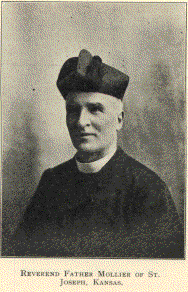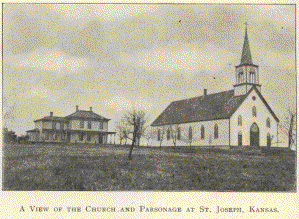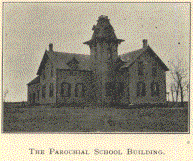REVEREND LOUIS MOLLIER.
 REVEREND FATHER MOLLIER OF
REVEREND FATHER MOLLIER OFST. JOSEPH, KANSAS. |
The villages dotted along the route were Clyde, Concordia, Elm Creek, Delphos, Clay Center, Strawberry and Parsons Creeks, Palmer, Greenleaf, Beloit, Lawrenceburg, Cawker City, Jewell Ciy,[sic] Stockton and other places, making his start from St. Joseph. In many of these places his spiritual guidance was needed, and Father Mollier has been known on several occasions to travel a distance of one hundred and twenty miles to give church consolation to sick and dying persons. At the time Father Mollier came to western Kansas, Clyde was a very small village and Concordia numbered a population of about three hundred. At that period the land office was the central attraction.
Father Mollier commenced the first church edifice at Elm Creek in 1874, which has recently been taken down. Mass was said at St. Joseph in a small school house until a church could be erected, and in this small edifice the good seeds were sown to ripen into bountiful harvests. Father Mollier began and had the St. Joseph and Concordia churches under course of construction at the same time. The church at St. Joseph was erected at an expense of about ten thousand dollars and four thousand dollars for the edifice at Concordia. The money was obtained through his efforts, the parishioners cheerfully giving for the privilege of a place of worship to hold the increasing population. A part of the parsonage was built in 1875 and in 1885 an upright addition to the building was erected, which is now a commodious and convenient residence.

A VIEW OF THE CHURCH AND PARSONAGE AT ST. JOSEPH, KANSAS.
The dimensions of the St. Joseph church are forty by one hundred feet, a fine building of which the town is justly proud. In 1880 Father Mollier built the Jamestown church and has erected mission churches at Greenleaf, Palmer, Clyde, Concordia and Clay Center. At the same time lots were secured at Beloit and Cawker City and building material put on the ground. The first school at St. Joseph was organized as district No. 35. The settlement is made up from the French people who first located in Kankakee, Illinois, which is a French speaking town. A few families emigrated to Kansas, others followed and through this medium, in turn, others came, thus making almost a branch of Kankakee. There is but one Protestant family in the entire parish.

THE PAROCHIAL SCHOOL BUILDING.
In the year 1885, a new school building was constructed, two stories high, containing four rooms. At the present time three teachers are busily employed, but as the season advances a fourth one is added. Sister Euphrasia, Sister Dorothy, and Sister Anthony are the present teachers. These kind, gentle, patient Sisters are of the St. Joseph order of Concordia. Sister Euphrasia teaches the French language, as many descendants of the French family are English speaking. The enrollment of the academy in 1902 was one hundred and thirteen, and the previous year numbered one hundred and seventy-five pupils. The school is a parochial one and the Sisters are the only teachers employed. The parish consists of one hundred and sixty families and the population is nine hundred and eleven. The parish extends three miles north, four to the west, eight to the south and six miles east.
Father Mollier could never dream of or dare hope to see a bishop in charge and at the head of the diocese at Concordia, so few families, numbering only about twenty when his labors began, and a portion of them belonged to Jamestown, but the increase can scarcely be numbered. In the early days there were but a few Catholics in Clyde and they went to St. Joseph to attend services. The church grounds contain ten acres donated by John B. Cardinal, who made an exchange with William Berland for the cemetery grounds in order that it might be adjacent to the church.
St. Joseph is situated six miles south of Clyde, surrounded by fine farms, showing the march of improvement time has made. The church, school and additional buildings can be seen for miles. Father Mollier still lives at St. Joseph, where he has devoted so many years to the education of children and the salvation of souls. When his work is ended and he lays down his worldly cross, the crown that awaits him will have been faithfully earned, for this good father has given a whole lifetime, unselfishly to the good and holy cause of the church and the beautiful teachings of Christto follow in his footsteps. Father Mollier has faithfully followed his command.
![]()
Transcribed from E.F. Hollibaugh's Biographical history of Cloud County, Kansas biographies of representative citizens. Illustrated with portraits of prominent people, cuts of homes, stock, etc. [n.p., 1903] 919p. illus., ports. 28 cm.
